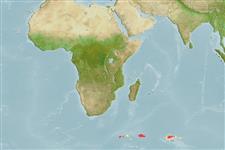Common names from other countries
Elasmobranchii (Haie und Rochen) (sharks and rays) >
Rajiformes (Skates and rays) >
Rajidae (Skates)
Etymology: Amblyraja: Greek, amblys = darkness + Latin, raja, -ae = ray (Raja sp.) (Ref. 45335).
Issue
Possibly a junior synonym of A. hyperborea due to strong morphological similarity according to Ebert & Stehmann (2013, Ref. 98315) and Weigmann (2016, Ref. 118749) (Ref. 118749).
Environment: milieu / climate zone / depth range / distribution range
Ökologie
seewasser bathydemersal; tiefenbereich 150 - 600 m (Ref. 114953), usually 375 - 390 m (Ref. 58018). Polar; 35°S - 49°S, 180°W - 180°E
Southeastern Atlantic: South Africa (Compagno et al. in Ebert et al. 2009 but see Ref. 114953); Indian Ocean: Crozet I. (Ref. 45488). Subantarctic: Widespread.
Size / Gewicht / Alter
Maturity: Lm ? range ? - ? cm
Max length : 90.0 cm TL Männchen/unbestimmt; (Ref. 114953)
Found on insular shelves and slopes. Mainly feeds on benthic invertebrates and bony fishes (Ref. 114953). Oviparous (Ref. 50449). Eggs have horn-like projections on the shell (Ref. 205). Young hatches at ca. 17 cm TL (Ref. 114953).
Life cycle and mating behavior
Maturities | Fortpflanzung | Spawnings | Egg(s) | Fecundities | Larven
Oviparous, paired eggs are laid. Embryos feed solely on yolk (Ref. 50449). Eggs have horn-like projections on the shell (Ref. 205).
McEachran, J.D. and K.A. Dunn, 1998. Phylogenetic analysis of skates, a morphologically conservative clade of elasmobranchs (Chondrichthyes: Rajidae). Copeia 1998(2):271-290. (Ref. 27314)
IUCN Rote Liste Status (Ref. 130435)
CITES (Ref. 128078)
Not Evaluated
Bedrohung für Menschen
Harmless
Nutzung durch Menschen
Fischereien: kleinfischerei
Tools
Zusatzinformationen
Download XML
Internet Quellen
Estimates based on models
Preferred temperature (Ref.
115969): 1.4 - 2.3, mean 2 (based on 27 cells).
Phylogenetic diversity index (Ref.
82804): PD
50 = 0.5010 [Uniqueness, from 0.5 = low to 2.0 = high].
Bayesian length-weight: a=0.00302 (0.00141 - 0.00645), b=3.24 (3.07 - 3.41), in cm Total Length, based on LWR estimates for this (Sub)family-body shape (Ref.
93245).
Trophic level (Ref.
69278): 4.2 ±0.3 se; based on size and trophs of closest relatives
Widerstandsfähigkeit (Ref.
120179): niedrig, Verdopplung der Population dauert 4,5 - 14 Jahre. (Fec assumed to be <100).
Fishing Vulnerability (Ref.
59153): High vulnerability (56 of 100).
Climate Vulnerability (Ref.
125649): Very high vulnerability (100 of 100).
